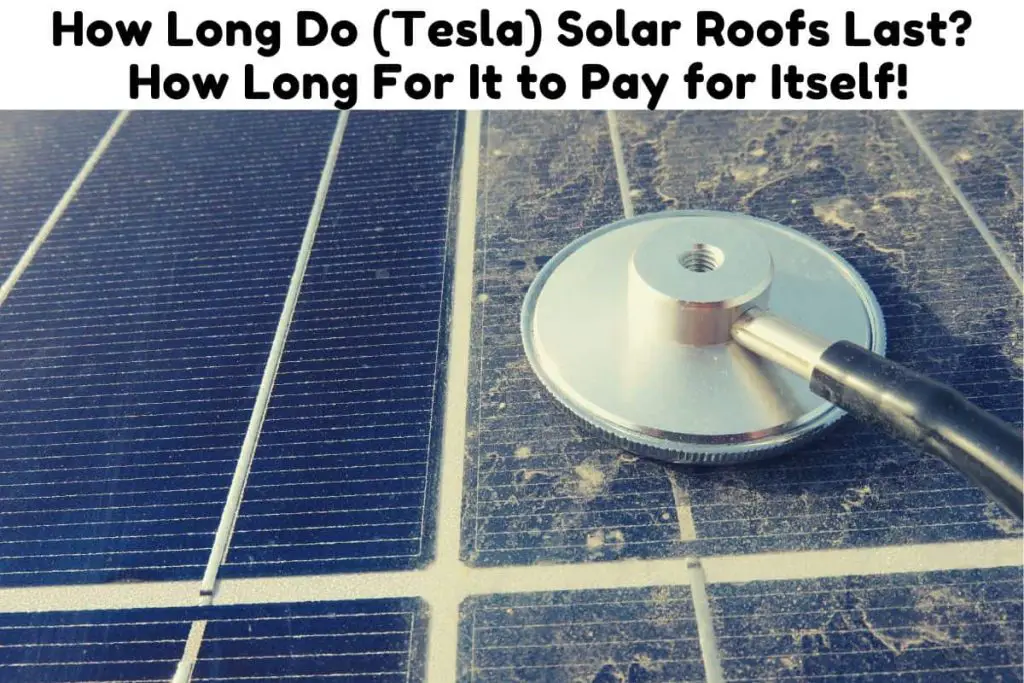A solar roof lasts for 25 years. But how do solar roofs work and are they better than solar panels? Those are the questions we want to answer in this article.
Solar roofs continue to grow in popularity since Tesla launched the first solar roof in 2016. Before then your only option, if you wanted to go solar, was to have several solar panels attached to your roof.
Although the first version of the Tesla solar roof had many technical flaws like low efficiency, it solved a big problem for many conscientious homeowners. It brought the good design to a product that up until then had looked very clumsy and unappealing.

How Long Do Tesla Solar Roofs Last?
A Tesla solar roof has a warranty of 25 years. The warranty guarantees a minimum energy output and protection in the event of damage to the roof by the weather.
On a side note! If you’re in need of a reliable and high-performance portable solar panel, We strongly recommend the Jackery SolarSaga 100W Portable Solar Panel (Amazon Link).
With a high conversion efficiency and foldable design, this solar panel is easy to transport and set up, making it perfect for outdoor activities like camping, hiking, and RV trips.

The US solar cell technology used in this panel ensures that you get the most efficient and reliable solar charging possible.
There is also a 60W option that is more affordable (Amazon Link)
Solar panel manufacturers warranty their panels for 25 years. Tesla has a lifetime warranty on any damage to solar tiles. That means if one of the tiles breaks, you are covered for any repair or replacement. With that said, however, the first Tesla roofs have only been in operation since 2018. Traditional solar panels have been around for more than 50 years. It remains to be seen how well their warranty holds up. (Source)
Today Tesla is competing against several manufacturers for market share in the solar roof space. Since 2016, Tesla has released two updates to its solar roof. How does it compare and are the improvements worth paying the high price tag?
How Does a Tesla Solar Roof Work?
A solar roof is a type of Building Integrated Photovoltaic (BIPV). A BIPV is a solar panel designed to look like it is part of the building. This might be anything from a window, a handrail, or in the case of a solar roof, a shingle.
A BIPV aims to match the solar cell to its surroundings. Solar shingles look exactly like ordinary roof shingles except they are made of photovoltaic cells. These cells work like any other solar panels in that they absorb light and convert it into electricity.
A solar roof performs two functions. Firstly, it protects your home from the weather like an ordinary roof. Secondly, it produces electricity which you can use to power your home. (Source)
Does the whole roof work as a solar panel?
A Tesla solar roof has active and inactive shingles. The active shingles contain solar cells exactly like those you find in conventional solar panels. These cells produce solar energy. Inactive shingles if you haven’t already guessed, do not produce energy. They are ordinary shingles that look like active shingles so you can’t tell the difference between them.
Why don’t they just make all the shingles, active shingles? Doing so would be inefficient. The roof would produce far more energy than you would need. Having some shingles inactive works out better in terms of cost and efficiency.
Are Solar Roofs Better Than Solar Panels?
For the most part, solar panels are a better option compared to solar roofs. Solar panels are much cheaper and they are more efficient. You will pay less and get more energy if you opt for solar panels.
Solar roofs come with a high premium. The reason is that they look so much better than the relatively clumsier aesthetic of sticking solar panels on your roof.
When you purchase a solar roof, you’re buying two products. A new roof and solar panels. That is mainly what makes it more expensive. A solar roof costs between 30,000 to $70,000. That is before you factor in the labor costs. Installation costs will vary depending on your location.
Solar panels will cost you a lot less. Even if your factor in the cost of adding a new roof along with your solar panels, you will pay up to $10,000 less than you would if you went out and bought a solar roof. (Source)
Solar roofs are worth it if the look of your home is more important to you than cost or efficiency. If you want solar but find the look of solar panels unattractive then a solar roof is the perfect alternative.
Also, check out our post ” Where Can You Buy Solar Roof Tiles? What You Need To Know!“
Are There Any Tax Incentives on Solar Roofs?
You can lower the cost of a solar roof by up to 30% when you apply for a tax credit. In the U.S homeowners who purchase solar are eligible for federal and local tax rebates.
Tax credits are given to anyone who purchases a solar system. Solar roofs are a solar system so you can apply for a tax credit. There are three types of tax credits that apply to solar systems.
- The federal solar tax credit allows you a 26% return on the upfront price of your solar system if it’s installed before the end of 2022. In 2023 this will be revised downward to 22% before it is retired in 2024.
- The property tax exemption simply means that you are exempt from paying tax on your solar system after you have added it as part of your property.
- A sales tax exemption means there is no sales tax on solar systems.
The federal solar tax credit applies across the U.S. The property tax and sales tax exemptions on the other hand, only apply in certain states. You can check if they apply in your state here. (Source)
To qualify for a rebate, the solar system must be purchased outright by the homeowner. You cannot receive a tax credit if you are leasing the system or if you are in a power purchase agreement. You also have to be a U.S citizen to qualify.
How Long Does It Take for A Solar Roof to Pay for Itself?
It can take anywhere between 8 to 40 years for a solar roof to pay for itself. The solar payback period depends on the upfront cost and the savings generated by the solar system. If you paid $40,000 for a solar roof and that roof generated $2,000 per year in savings, then the payback period for that roof would be 20 years.
